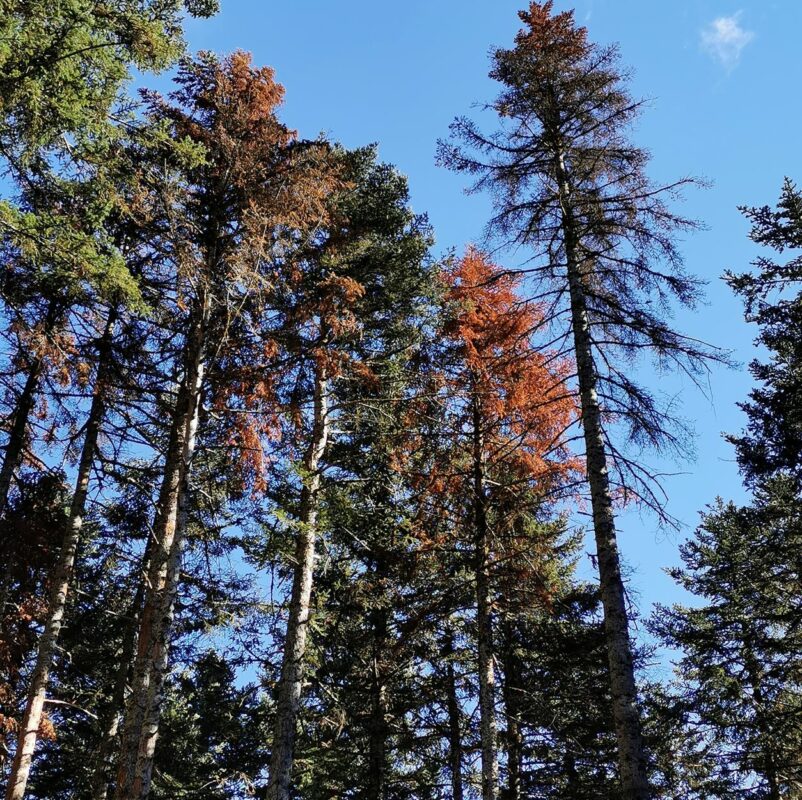Jonàs Oliva, CTFC and UdL researcher, has participated in an international research project that studies the interactive effect of drought and pathogenic infection on the mortality process in conifers.
Research shows that in drought conditions, trees prioritize keeping living tissues hydrated by sacrificing their defense capacity. Under continuous drought conditions, pathogen mortality triples.
Jonàs Oliva, researcher at the Forest Science and Technology Center of Catalonia (CTFC) and the University of Lleida- AGROTECNIO has led the development of a study published in the journal Plant, Cell & Environment on the contribution of tree pathogens in the mortality process under drought conditions. The study has had the participation of CREAF, the Instituto Pirenaico de Ecología (IPE-CSIC), and the Swedish University of Agricultural Sciences.
The research has focused on the physiological processes that affect Scot’s pines (Pinus sylvestris) and spruces (Picea abies) when they are affected by the pathogen Heterobasidion annosum s.s., a fungus that attacks the sapwood and heartwood of trees and causes internal decomposition of trunk and roots.
Heterobasidion annosum is a very abundant pathogen in the Pyrenees, where it is estimated that over 30% of fir trees are affected by the disease it causes. Firs and spruces are quite tolerant to the disease. Although diseased trees grow less, are susceptible to wind gusts, and lose most of their timber value, they do not usually die. This study has shown how drought transforms a chronic disease into a mortal one.
The results demonstrate the negative influence of drought on the ability of trees to defend themselves against the pathogen. Five months after inoculation, trees inoculated with the pathogen and subjected to drought conditions showed necrotic lesions twice as large as the inoculated trees that had been well-watered. The combined drought and pathogen treatment significantly increased the mortality of Picea, which died at a faster rate compared to trees that were subjected to either stressor independently.
During the research, the effects of stress factors such as drought or pathogens have been analyzed in both species of young trees, measuring their water levels, gas exchange, non-structural carbohydrates (NSC), defoliation, defense responses, and their relationship with mortality. The results have made it possible to advance the mechanisms behind the drought-pathogen interaction. On the one hand, drought reduces the trees’ carbon reserves and impairs their ability to build defense barriers and overcome the pathogen. On the other hand, the defense needed against this pathogen reduces the amount of carbon available for the tree to cope with water stress, negatively affecting its hydraulic performance and therefore increasing the mortality rate.
Although drought-induced tree mortality has been intensively studied in the past two decades, the pathways leading to tree mortality are still not fully understood. Tree mortality often arises from an interaction between biotic (pests and pathogens) and abiotic stressors, rather than being the result of a single disturbance factor.
Climate change poses ever-greater challenges to forest ecosystems, and diseases not only emerge following the introduction of exotic pathogens into new environments but also by modifying their virulence due to climate-driven processes such as drought. Therefore, it is increasingly important to both predict the risk of an acceleration in the development of existing diseases linked to climate change, and to understand pathogen-induced tree death.
Further information:
Gomez-Gallego, M., Galiano, L., Martínez-Vilalta, J., Stenlid, J., Capador-Barreto, H.D., Elfstrand, M., Camarero, J.J. & Oliva, J. (2022) Interaction of drought- and pathogen-induced mortality in Norway spruce and Scots pine. Plant, Cell & Environment, 45, 2292– 2305. https://doi.org/10.1111/pce.14360
Last modified: 21 June 2023










